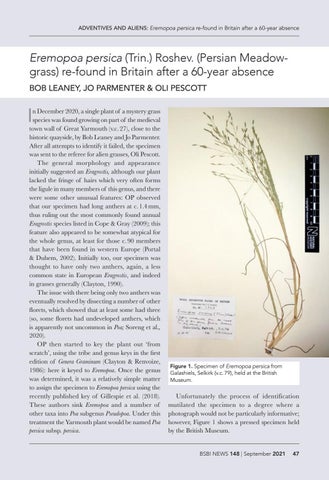ADVENTIVES AND ALIENS: Eremopoa persica re-found in Britain after a 60-year absence
Eremopoa persica (Trin.) Roshev. (Persian Meadowgrass) re-found in Britain after a 60-year absence BOB LEANEY, JO PARMENTER & OLI PESCOTT
I
n December 2020, a single plant of a mystery grass species was found growing on part of the medieval town wall of Great Yarmouth (v.c. 27), close to the historic quayside, by Bob Leaney and Jo Parmenter. After all attempts to identify it failed, the specimen was sent to the referee for alien grasses, Oli Pescott. The general morphology and appearance initially suggested an Eragrostis, although our plant lacked the fringe of hairs which very often forms the ligule in many members of this genus, and there were some other unusual features: OP observed that our specimen had long anthers at c. 1.4 mm, thus ruling out the most commonly found annual Eragrostis species listed in Cope & Gray (2009); this feature also appeared to be somewhat atypical for the whole genus, at least for those c. 90 members that have been found in western Europe (Portal & Duhem, 2002). Initially too, our specimen was thought to have only two anthers, again, a less common state in European Eragrostis, and indeed in grasses generally (Clayton, 1990). The issue with there being only two anthers was eventually resolved by dissecting a number of other florets, which showed that at least some had three (so, some florets had undeveloped anthers, which is apparently not uncommon in Poa; Soreng et al., 2020). OP then started to key the plant out ‘from scratch’, using the tribe and genus keys in the first edition of Genera Graminum (Clayton & Renvoize, 1986): here it keyed to Eremopoa. Once the genus was determined, it was a relatively simple matter to assign the specimen to Eremopoa persica using the recently published key of Gillespie et al. (2018). These authors sink Eremopoa and a number of other taxa into Poa subgenus Pseudopoa. Under this treatment the Yarmouth plant would be named Poa persica subsp. persica.
Figure 1. Specimen of Eremopoa persica from Galashiels, Selkirk (v.c. 79), held at the British Museum.
Unfortunately the process of identification mutilated the specimen to a degree where a photograph would not be particularly informative; however, Figure 1 shows a pressed specimen held by the British Museum. BSBI NEWS 148 | September 2021
47

















